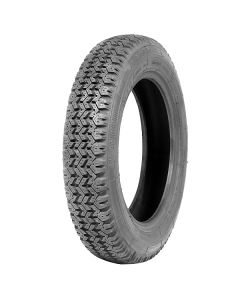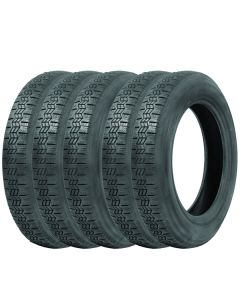Citroen 2CV Tyres

Citroen 2CV on 125-15 Michelin X Whitewall Tyres
Citroen 2CV 1948–1990
- Early Ripple Bonnet 2CV tyres are fitted with 125 R 400 Michelin X.
- Early 2CV cars on 400mm wheels can also fit 135 R 400 Michelin X.
- These tyres will be best fitted with a set of Michelin 16C innertubes. The 125 R 400 and 135 R 400 Michelin X are tube-type tyres, they need an innertube to function.
At one point Citroen offered a million francs to anyone who managed to overturn a 2CV through a corner on a public road. No-one claimed. The very low centre of mass and unique suspension helped. The Michelin X is an integral part of this suspension; the structural tread and soft sidewall allowed the tyre to flex and grip to a certain extent, before picking up some of the tread and sliding, preventing it from tipping over!
Citroen 2CV Tyres Explained
- Post 1960 Deux Chevaux require a set of 125 SR 15 Michelin X tyres.
- The correct 2CV innertube for tyres of this size is the Michelin 15CB.
- With all Citroen 2CV cars, it is critical to fit Michelin X.
- Michelin also make original 2CV tyres with a white wall: 125 SR 15 Michelin X Whitewall.
- Citroen 2 CV tyre pressures are typically 20 PSI front, 26 PSI rear.

Citroen 2cv on Whitewall Tyres
- Our period fitment guides inform us that by 1972 (possibly earlier), the 2CV was released on wheels capable of running tubeless tyres. If your 2CV is post-1972 innertubes are not needed, providing that your tyres are also tubeless.
- Even with tubeless wheels, innertubes can still be installed. If you have tube-type tyres, suffer a puncture, or are unsure if your rims are airtight, fitting innertubes can be prudent.
When the 2 CV was first developed it used 400mm wheels and fitted 125 R 400 Michelin X tyres. Then in 1960 Citroen changed to 15" wheels and fitted 125 SR 15 Michelin X tyres. There still isn't a better tyre for these cars. The design of the X carcass is an integral part of the design of the 2CV chassis.
How a 2CV was made in 1990
Michelin X 2CV Tyres
From 1949 to 1960 Citroen fitted a 125 R 400 Michelin X to their early Deux Chevaux. From 1960 the 2CV fitted a 125-380 Michelin X. This description has the rim diameter described as 380mm; today the rim is described in inches; so the 125 SR 15 Michelin X is the correct tyre. Fitting the correct Michelin X 125R15 to the Deux Chevaux is absolutely critical; the carcase structure is like nothing else and combined with the square-shouldered thin tread is an important part of the cars suspension and steering geometry. The 2CV and Michelin X 125R15 tyres were developed to work together. Michelin also make a 135SR15 Michelin X M+S (Mud and Snow) tyre.
For normal road use Michelin also make a 135 SR 15 Michelin ZX. However, 135 and ZX are not right on the car, with too much footprint a tall carcase with a tread pattern that is the wrong shape. Citroens 2 CV need the 125 SR 15 Michelin X. In Spain the standard equipment for a 2cv was a 135x15 Michelin ZX. The 135 SR 15 Michelin ZX was also fitted to the Citroen Ami.

Citroen 2CV Longstone Advert
Deux Chevaux Tyres
There are a variety of cheap 2CV Citroen Tyres available. However, these tyres are nowhere near the quality of the Michelin 2CV Citroen. Also when the 2CV was made it was designed to fit the Michelin X by Citroen while they were owned by Michelin. It is worth noting that the carcass design and structure of the Michelin X is different to other tyres, particularly modern tyres, and it is this carcass structure that is integral to the steering and suspension of Citroens little old Deux Chevaux. Michelin now also manufactures the original 125 SR 15 X with a white wall band as well.
What are the best tyres for a Citroen 1974 2CV?
From 1960 to the end of 2CV production, the best, and only tyre for a Citroen 2 CV has to be the 125 SR 15 Michelin X. The little Deux Chevaux was designed by Michelin with the Michelin X tyre in mind.
Michelin now make this important Citroen 2CV tyre with a white wall - 125 SR 15 Michelin X Whitewall.
What were the original tyres on a 1962 2CV?
Michelin patented the radial tyre in 1946. The early Ripple Bonnet 2CV was one of the very first cars to fit radial tyres as standard equipment Radial tyres in those days were very expensive, but the dramatically improved longevity made them financially economic. This 125mm section X radial tyre was an integral part of what made the 2CV such a ground-breaking car. When Michelin first developed the radial tyre they were only made to fit 400mm wheels in a world where all other wheels were in inches. So the first 2CV tyres were called 125-400 Michelin X.
2CV Leaning Video
By 1960, other tyre manufacturers, namely Pirelli, were making radial tyres to fit inch wheels sizes. As a result, Michelin followed suit, so the 2 CV fitted 15” wheels and started to fit 125SR15 Michelin X. Critically they were still the Michelin X carcass structure. However Michelin being as French as they were, they still couldn’t bear the idea of having inch sizes so the first 125SR15 X 2CV tyres were measured in millimetres so the original description printed on the side of the 1960s 2CV tyres was 125SR380 Michelin X (because 15” = 380mm).
So, in short, the answer to the question; what were the original tyres on a 1962 2CV is it was a 125 SR 15 Michelin X, However at the time the same tyre would have had the description 125 – 380 Michelin X written on the sidewall.
History of the Citroën 2CV
Following Citroën's success with the ground-breaking Traction Avant, they were met with several investment costs that proved to be too much for Citroën to be able to pay, leading to Citroen to file for bankruptcy in the December of 1934. Following this, Michelin became the majority shareholder in Citroën. The now Michelin-led Citroën started market research, commissioning a market survey which concluded that a Car was needed for the rural population of France that could not afford a car.

Citroen 2CV Suspension
Following the results of the survey, the 2CV design criteria were created, a cheap but robust car with good fuel economy was the basis for the project. The brief detailed some very specific outliers such as the ability to transport eggs over a freshly ploughed field without breakage for example. In 1936 the design team of the Traction Avant was put to work designing what was then only called the TPV (Toute Petite Voiture - "Very Small Car").
In 1939 the car received approval for the Domestic Market and was ready to be unveiled at the Paris Motor Show that October, this never came to be, however, as France declared war on Nazi Germany on the 3rd of September 1939.

Citroen 2CV Chassis
The launch of the 2CVs was cancelled and Michelin made the decision to hide the TPV prototypes from the Nazis, as they believed it would be drawn into military applications just as the Volkswagen Beetle was. Initially, the 2CV was to be made with aluminium, until the cost of aluminium soared to an increase of 40%. Citroën concluded that making the TPV post-war would not be economically viable, so they switched to using mostly steel flat panels. There was an array of roadblocks to the creation of the 2CV from the Nazi party and also the 1944 French Government who planned to ration car production amongst other scarce resources.

2CV on Michelin X Tyres
Finally in 1948, the Type A 2CV was unveiled and it was an instant hit amongst the lower-income members of the French population, giving them a car that met their needs for a brilliant price. Despite ridicule from many critics, the 2CV actually built up a huge waiting list due to the high demand for these cars, making second-hand sales actually more expensive due to the popularity of these cars and people not wanting to wait for the years-long queue to cut down.
The 2CV came when France needed it most, offering many who may never have been able to afford a car at the time, a cheap to buy and cheap to run, reliable motor, allowing those affected by the war to be able to travel for work and pleasure alike. There have been many variations since production, with the 2CV van being an incredibly popular model in the period as well as having a modern cult following. The 2CV Charleston, AZL, and of course the 2CV-007 which was released to coincide with the Bond film "For Your Eyes Only". The 2CV was produced for 42 years, by which time it was just too old of a design to keep up with its modern contemporaries in terms of speed and safety, production ended in 1990.















